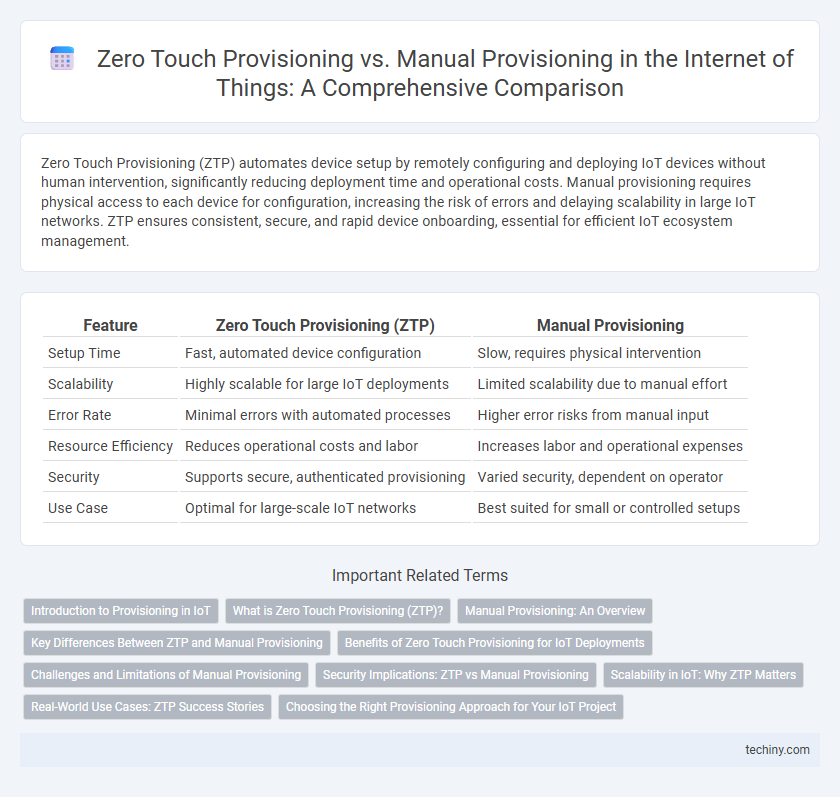Zero Touch Provisioning (ZTP) automates device setup by remotely configuring and deploying IoT devices without human intervention, significantly reducing deployment time and operational costs. Manual provisioning requires physical access to each device for configuration, increasing the risk of errors and delaying scalability in large IoT networks. ZTP ensures consistent, secure, and rapid device onboarding, essential for efficient IoT ecosystem management.
Table of Comparison
| Feature | Zero Touch Provisioning (ZTP) | Manual Provisioning |
|---|---|---|
| Setup Time | Fast, automated device configuration | Slow, requires physical intervention |
| Scalability | Highly scalable for large IoT deployments | Limited scalability due to manual effort |
| Error Rate | Minimal errors with automated processes | Higher error risks from manual input |
| Resource Efficiency | Reduces operational costs and labor | Increases labor and operational expenses |
| Security | Supports secure, authenticated provisioning | Varied security, dependent on operator |
| Use Case | Optimal for large-scale IoT networks | Best suited for small or controlled setups |
Introduction to Provisioning in IoT
Zero Touch Provisioning in IoT automates device configuration and deployment, minimizing human intervention and reducing setup time, while manual provisioning requires physical access and individual device configuration. Automated provisioning enhances scalability and security by enabling remote updates and consistent policy application across extensive IoT networks. Efficient provisioning methods are critical for managing connected devices in smart environments, industrial systems, and large-scale sensor deployments.
What is Zero Touch Provisioning (ZTP)?
Zero Touch Provisioning (ZTP) automates the configuration and deployment of Internet of Things (IoT) devices by remotely provisioning them without manual intervention. It enables scalable, secure, and efficient device onboarding, reducing errors and operational costs compared to manual provisioning. ZTP leverages cloud-based services and predefined templates to instantly connect IoT devices to networks and management systems upon powering on.
Manual Provisioning: An Overview
Manual provisioning in the Internet of Things (IoT) involves configuring devices individually by human operators, which can be time-consuming and prone to errors. This method requires physical access to each IoT device for setup, including network credentials, security keys, and operational parameters. Despite its labor-intensive nature, manual provisioning offers granular control over device configurations, making it suitable for small-scale deployments or specialized environments where automated systems may lack flexibility.
Key Differences Between ZTP and Manual Provisioning
Zero Touch Provisioning (ZTP) automates device configuration by enabling IoT devices to self-provision using predefined templates and cloud-based management, significantly reducing deployment time and human error. Manual provisioning requires direct human intervention for device setup, configuration, and validation, leading to slower rollouts and increased operational costs. ZTP enhances scalability and consistency in large IoT networks, whereas manual provisioning remains suitable for smaller deployments or highly customized configurations.
Benefits of Zero Touch Provisioning for IoT Deployments
Zero Touch Provisioning (ZTP) eliminates the need for manual configuration in IoT deployments, significantly reducing setup time and human error. It enables automatic device registration, configuration, and firmware updates, enhancing scalability and operational efficiency across vast IoT networks. ZTP ensures faster device onboarding, improved security through standardized provisioning, and lowers total cost of ownership compared to manual provisioning methods.
Challenges and Limitations of Manual Provisioning
Manual provisioning in the Internet of Things (IoT) poses significant challenges, including increased risk of human error, inconsistent device configurations, and prolonged deployment times. This process demands substantial technical expertise and intensive labor, leading to scalability issues as the number of connected devices grows exponentially. Manual provisioning also limits real-time updates and dynamic device management, resulting in slower response to security vulnerabilities and network changes.
Security Implications: ZTP vs Manual Provisioning
Zero Touch Provisioning (ZTP) significantly reduces security risks by automating device setup to eliminate manual configuration errors and unauthorized access during deployment. Manual provisioning exposes IoT devices to greater vulnerabilities due to human error, inconsistent security settings, and the potential for credential interception. Implementing ZTP enhances overall security posture by enforcing standardized policies and secure key distribution from the initial device activation.
Scalability in IoT: Why ZTP Matters
Zero Touch Provisioning (ZTP) significantly enhances scalability in IoT deployments by automating device configuration and reducing the need for manual intervention, enabling rapid onboarding of thousands of devices simultaneously. Manual provisioning becomes impractical as IoT ecosystems grow, leading to increased operational costs, human errors, and deployment delays. Embracing ZTP ensures efficient resource allocation and seamless expansion of IoT networks, vital for industries requiring large-scale, secure device management.
Real-World Use Cases: ZTP Success Stories
Zero Touch Provisioning (ZTP) enables seamless, automated IoT device deployment across large-scale industrial environments, significantly reducing configuration errors and operational costs compared to Manual Provisioning. Real-world success stories include smart city projects where ZTP accelerated sensor network rollouts, and manufacturing plants that achieved rapid scaling of connected machinery without on-site IT intervention. These case studies highlight ZTP's ability to streamline device onboarding, enhance security through standardized configurations, and ensure consistent performance in diverse IoT ecosystems.
Choosing the Right Provisioning Approach for Your IoT Project
Zero Touch Provisioning (ZTP) streamlines IoT device deployment by automating configuration and reducing human error, making it ideal for large-scale projects with dynamic environments. Manual provisioning, though labor-intensive and prone to inconsistencies, offers granular control suitable for smaller, highly customized IoT setups. Selecting the right provisioning approach depends on factors like project scale, device diversity, deployment speed requirements, and long-term management capabilities.
Zero Touch Provisioning vs Manual Provisioning Infographic

 techiny.com
techiny.com